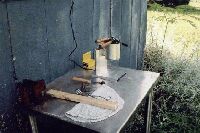Last year, Joey shot sabots with Speer .45 caliber pistol bullets, but wanted to try casting his own. He decided on a Lee Precision mold that would cast the 320 gr REAL bullet (Rifling Engraved at Loading). I ordered one from MidSouth Shooters Supply. So, with my Lee Production Pot in a shady spot in the backyard, a supply of pure lead, and mold and skimmers, he began production of REAL bullets. He started by reading and following the instructions that came with the mold.
Lead is a deadly poison. I work lead outside because I want to stay away from the vapor. After reviewing the safety concerns, we plugged in the pot and filled it with lead. Putting the mold on top of the pot serves to preheat it. You can't get good bullets unless the mold is hot and the lead flows into the cavity fully. When the lead was molten, a scum of slag formed on top. This slag is dirt and crud that collects on the metal while it is stored. We don't want that in our bullets, so we skim it. The slag also contains lead oxide and we want to dispose of that properly.
Okay, Dennis, you ask, what would you do in the event of a sudden rainstorm? Good question! I would get away from the pot, kill the power to it, and wait until everything was cool to the touch before I started to clean up the mess. I can buy more lead. I can't buy arms or eyes. Joey began casting. The first few bullets came out misshapen. The mold wasn't filling properly, probably because it wasn't hot enough. I told him to keep casting, and bright, shiny bullets were soon falling on the table. Those bullets, when they come out of the pot, are hot and soft. I drop mine on a piece of cloth so they don't deform hitting the table. Joey got his rhythm and before long, it was time to add more metal. We added more metal and his sprues and mis-cast bullets to the pot. One of the best parts of casting your own bullets is that if you make a mistake and mis-cast a bullet, it can go back in the pot. Very little lead is wasted. When the melt was hot, we skimmed again, and Joey was soon back in business. The rhythm continued until he decided he had enough. We gathered our new bullets, put the discards back in the pot and cleaned the work area. Later that night, we lubed the bullets with Liquid Alox. Lee Precision sells it, and I think it does as good a job as anything else for cast bullets. This stuff comes in small bottles, and I suspect that because it is has a proprietary name (ALOX), it is manufactured by the Alox Corp and Mr. Lee puts it in smaller bottles. It is a tumble lube. What you do is put your cast bullets in a container (I do mine in a sandwich bag.), squirt a little Liquid Alox on them, and tumble them until they are coated. Stand them on waxed paper to dry overnight. The next morning, your bullets have a waxy coating on them that smells like varnish. It reminds me, more than anything, of that old lube they used to put on .22 bullets.
Bullet casting is a fine way to spend an afternoon with your son (or daughter, or your Dad). In an hour, you can have enough bullets for an afternoon of shooting. In an afternoon of casting, you can have enough bullets for a year of shooting. Joey is making his own bullets, now, in the great traditions of shooting. Pure lead is fairly easy to find. If you can cut it with your thumbnail, it is soft enough for black powder. They can even be cast over a campfire. Personally, I get a lot of satisfaction using things homemade, and a bullet cast in the backyard is a magnificent way to turn scrap into pleasure.
From my stand a half-mile away, I'll probably hear his shout. Don't you think?
|



